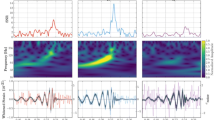Abstract
The correlation between the data obtained with two gravitational wave (GW) detectors (in Rome and in Maryland) and two neutrino detectors (LSD in Italy and Kamiokande in Japan) has been studied in more detail. If we indicate with U1 the response of the gravitational wave detectors and with U2 the response of the neutrino detectors, we find that there is a clear time correlation between U1 and U2: namely U2 comes later than U1 by an amount depending on the energy measured in the neutrino detectors (the delay decreases with the detected neutrino energy). A straightforward calculation would yield a mass for the U2 particles between 4 and 6 eV. If one further assumes that the U2 is due to neutrinos whose mass has been evaluated to be less than 0.1 eV (at 90% c.l.), we hazard the idea that a slow down during the neutrinos’ 168 000 light-year travel from SN1987A to Earth could be inferred.








Similar content being viewed by others
Notes
Giuliano Preparata calculated a much larger cross-section in his superradiance theory (Preparata, 1990).
Not considering the larger cross-section in the Preparata superradiance theory (Preparata, 1990).
REFERENCES
M. Aglietta, G. Badino, G. Bologna, et al., Nuovo Cimento C, Ser. 1 12C, 75 (1989).
M. Aglietta, A. Castellina, W. Fulgione, et al., Nuovo Cimento C, Ser. 1 14C, 171 (1991).
M. Aker et al. (KATRIN Collab.), arXiv:1909.06048 (2019).
E. Amaldi, P. Bonifazi, M. G. Castellano, et al., Europhys. Lett. 3, 1325 (1987).
F. Couchot, S. Henrot-Versille, O. Perdereau, et al., Astron. and Astrophys. 606, A104 (2017).
Yu. N. Eroshenko, E. O. Babichev, V. I. Dokuchaev, and A. S. Malgin, J. Experimental Theoretical Physics 128 (4), 599 (2019).
P. Galeotti and G. Pizzella, Europ. Phys. J. C 76 (8), 426 (2016).
V. S. Imshennik and O. G. Ryazhskaya, Astron. Lett. 30, 14 (2004).
G. Preparata, Modern Physics Lett. A, 5 (1), 1 (1990).
M. Tanabashi et al. (Particle Data Group), Phys. Rev. D 98 (3) id. 030001 (2018).
ACKNOWLEDGMENTS
We thank the Kamiokande, the LSD and the Rome Collaboration for having supplied to us their data. We thank Marcello Piccolo for useful discussions and suggestions, Paolo Lipari, Eligio Lisi and Francesco Vissani for suggestions on neutrino masses.
Author information
Authors and Affiliations
Corresponding author
Ethics declarations
The authors declare no conflict of interest.
Rights and permissions
About this article
Cite this article
Buccella, F., Pallottino, G.V., Galeotti, P. et al. Correlation of Gravitational Waves–Neutrino Detectors: The Long Neutrino Voyage from SN1987A. Astrophys. Bull. 75, 110–116 (2020). https://doi.org/10.1134/S1990341320020042
Received:
Revised:
Accepted:
Published:
Issue Date:
DOI: https://doi.org/10.1134/S1990341320020042




